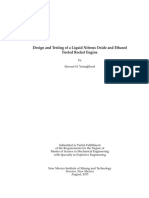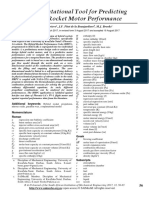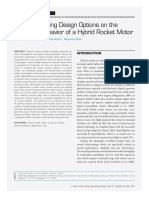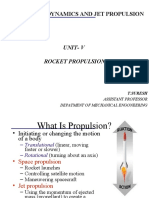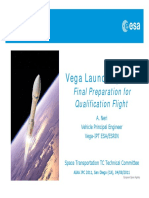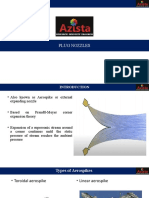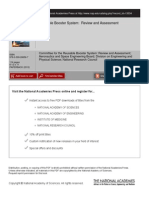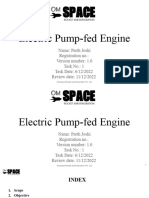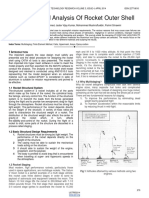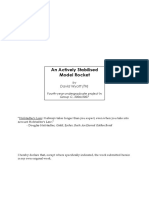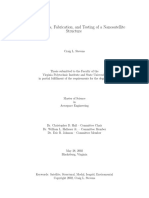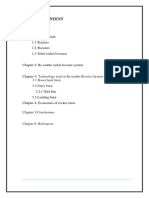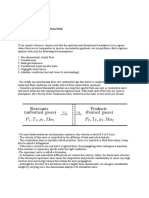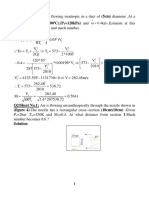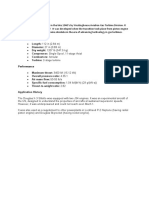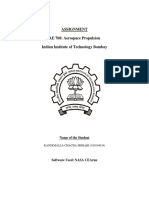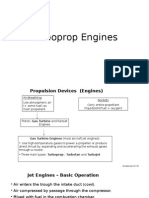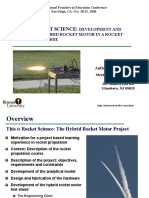Principles of Rocket Propulsion
Introduction
A rocket is a machine that develops thrust by the rapid expulsion of matter. The
major components of a chemical rocket assembly are a rocket motor or engine,
propellant consisting of fuel and an oxidizer, a frame to hold the components,
control systems and a cargo such as a satellite. A rocket differs from other
engines in that it carries its fuel and oxidizer internally, therefore it will burn in
the vacuum of space as well as within the Earth's atmosphere. The cargo is
commonly referred to as the payload. A rocket is called a launch vehicle when
it is used to launch a satellite or other payload into space. A rocket becomes a
missile when the payload is a warhead and it is used as a weapon. At present,
rockets are the only means capable of achieving the altitude and velocity
necessary to put a payload into orbit.
Rocket Principles
A rocket in its simplest form is a chamber enclosing a gas under pressure. A
small opening at one end of the chamber allows the gas to escape, and in doing
so provides a thrust that propels the rocket in the opposite direction. A good
example of this is a balloon. Air inside a balloon is compressed
by the balloon's rubber walls. The air pushes back so that the
forces on each side are balanced. When the nozzle is released,
air escapes through it and the balloon is propelled in the
opposite direction.
With space rockets, the gas is produced by burning propellants
that can be solid or liquid in form or a combination of the two.
�Terms to
There are a number of terms used to describe the power generated by a rocket.
Describe
Rocket Power
Thrust is the force generated, measured in pounds or kilograms. Thrust
generated by the first stage must be greater than the weight of the
complete launch vehicle while standing on the launch pad in order to
get it moving. Once moving upward, thrust must continue to be
generated to accelerate the launch vehicle against the force of the
Earth's gravity. To place a satellite into orbit around the Earth, thrust
must continue until the minimum altitude and orbital velocity have
been attained or the launch vehicle will fall back to the Earth.
Minimum altitude is rarely desirable, therefore thrust must continue to
be generated to gain additional orbital altitude.
Launch Vehicles
The impulse, sometimes called total impulse, is the product of thrust
and the effective firing duration. A shoulder fired rocket such as the
LAW has an average thrust of 600 lbs and a firing duration of 0.2
seconds for an impulse of 120 lbsec. The Saturn V rocket, used during
the Apollo program, not only generated much more thrust but also for a
much longer time. It had an impulse of 1.15 billion lbsec.
The efficiency of a rocket engine is measured by its specific impulse
(Isp). Specific impulse is defined as the thrust divided by the mass of
propellant consumed per second. The result is expressed in seconds.
The specific impulse can be thought of as the number of seconds that
one pound of propellant will produce one pound of thrust. If thrust is
expressed in pounds, a specific impulse of 300 seconds is considered
good. Higher values are better.
A rocket's mass ratio is defined as the total mass at liftoff divided by
the mass remaining after all the propellant has been consumed. A high
mass ratio means that more propellant is pushing less launch vehicle
and payload mass, resulting in higher velocity. A high mass ratio is
necessary to achieve the high velocities needed to put a payload into
orbit.
�Launch
Vehicles
Most current launch vehicles consist of
two or more rockets or stages that are
stacked on top of each other. The
second stage is on top of the first, and
so on. The first stage is the one that
lifts the rocket off the launch pad and
is sometimes known also as a
"booster" or "main stage". When the
first stage runs out of propellant or has
reached the desired altitude and
velocity, its rocket engine is turned off
and it is separated so that the
subsequent stages do not have to
propel unnecessary mass. Dropping
away the useless weight of stages
whose propellant has been expended
means less powerful engines can be
used to continue the acceleration,
which means less propellant has to be
carried, which in turn means more
payload can be placed into orbit.
Rocket
Engines
Many different types of rocket engines have been designed or proposed.
Currently, the most powerful are the chemical propellant rocket engines. Other
types being designed or that are proposed are ion rockets, photon rockets,
magnetohydrodynamic drives and nuclear fission rockets; however, they are
generally more suitable for providing long term thrust in space rather than
launching a rocket and its payload from the Earth's surface into space.
Categories
of
Chemical
Propellants
There are three categories of chemical propellants for rocket engines: liquid
propellant, solid propellant, and hybrid propellant. The propellant for a chemical
rocket engine usually consists of a fuel and an oxidizer. Sometimes a catalyst is
added to enhance the chemical reaction between the fuel and the oxidizer. Each
category has advantages and disadvantages that make them best for certain
applications and unsuitable for others.
Liquid
Liquid propellant rocket engines burn two separately stored liquid chemicals, a
Propellants fuel and an oxidizer, to produce thrust. Typical fuel/oxidizer combinations are:
TYPICAL LIQUID PROPELLANT PURL/OXIDIZER COMBINATIONS
�FUEL
OXIDIZER
TYPE
Liquid Hydrogen
Liquid Oxygen
Cryogenic
RP-1 Kerosene
Liquid Oxygen
Liquid/Cryogenic
Aniline
Nitric Acid
Hypergolic
Hydrazine
Monopropellant
Cryogenic
Propellant
A cryogenic propellant is one that uses very cold, liquefied gases as the fuel and
the oxidizer. Liquid oxygen boils at 297 F and liquid hydrogen boils at 423 F.
Cryogenic propellants require special insulated containers and vents to allow gas
from the evaporating liquids to escape. The liquid fuel and oxidizer are pumped
from the storage tanks to an expansion chamber and injected into the combustion
chamber where they are mixed and ignited by a flame or spark. The fuel expands
as it burns and the hot exhaust gases are directed out of the nozzle to provide
thrust.
Hypergolic
Propellant
A hypergolic propellant is composed of a fuel and oxidizer that ignite when they
come into contact with each other. No spark is needed. Hypergolic propellants are
typically corrosive so storage requires special containers and safety facilities.
MonoMonopropellants combine the properties of fuel and oxidizer in one chemical. By
propellants their nature, monopropellants are unstable and dangerous. Monopropellants are
typically used in adjusting or vernier rockets to provide thrust for making
changes to orbits once the payload is in orbit.
6-2 Launch Vehicles, cont'd
Advantages
Advantages of liquid propellant rockets include the highest energy per unit of
and
fuel mass, variable thrust, and a restart capability. Raw materials, such as
Disadvantages oxygen and hydrogen are in abundant supply and a relatively easy to
manufacture. Disadvantages of liquid propellant rockets include requirements
for complex storage containers, complex plumbing, precise fuel and oxidizer
injection metering, high speed/high capacity pumps, and difficulty in storing
fueled rockets.
Solid
Propellants
Solid propellant rockets are basically combustion chamber tubes packed with a
propellant that contains both fuel and oxidizer blended together uniformly. The
principal advantage is that a solid propellant is relatively stable therefore it can
be manufactured and stored for future use. Solid propellants have a high
density and can burn very fast. They are relatively insensitive to shock,
vibration and acceleration. No propellant pumps are required thus the rocket
engines are less complicated. Disadvantages are that, once ignited, solid
propellants cannot be throttled, turned off and then restarted because they burn
until all the propellant is used. The surface area of the burning propellant is
critical in determining the amount of thrust being generated. Cracks in the
solid propellant increase the exposed surface area, thus the propellant burns
faster than planned. If too many cracks develop, pressure inside the engine
�rises significantly and the rocket engine may explode. Manufacture of a solid
propellant is an expensive, precision operation. Solid propellant rockets range
in size from the Light Antitank Weapon to the 100 foot long Solid Rocket
Boosters (SRBs) used on the side of the main fuel tank of the Space Shuttle.
Other examples include air defense missiles such as Patriot and Hawk, air to
air missiles such as Sidewinder, Sparrow, antitank missiles such as the TOW
and Hellfire, and Intercontinental Ballistic Missiles (ICBMs).
Hypbrid
Propellants
Hybrid propellant rocket engines attempt to capture the advantages of both
liquid and solid fueled rocket engines. The basic design of a hybrid consists of
a combustion chamber tube, similar to ordinary solid fueled rockets, packed
with a solid chemical, usually the fuel. Above the combustion chamber tube is
a tank, containing a complementary reactive liquid chemical, usually the
oxidizer. The two chemicals are hypergolic, and when the liquid chemical is
injected into the combustion chamber containing the solid chemical, ignition
occurs and thrust is produced. The ability to throttle the engine is achieved by
varying the amount of liquid injected per unit of time. The rocket engine can
be stopped by cutting off the flow of the liquid chemical. The engine can be
restarted by resuming the flow of the liquid chemical. Other advantages of
hybrid propellant rocket engines are that they provide higher energy than
standard solid propellant rockets, they can be throttled and restarted like liquid
propellant rockets, they can be stored for long periods like solid propellant
rockets, and they contain less than half the complex machinery (pumps,
plumbing) of standard liquid propellant engines. They are also less sensitive to
damage to the solid fuel component than standard solid propellant system.
Hybrid rockets control the combustion rate by metering the liquid component
of the fuel. No matter how much solid component surface area is exposed,
only so much can be burned in the presence of the liquid component.
Disadvantages are that these engines do not generate as much energy per
pound of propellant as liquid propellant engines and they are more complex
than standard solid fueled engines. Hybrid propellant rocket engines are still in
development and are not yet available for operational use. Versions with more
than 220,000 lbs (100,000 kg) of thrust have been demonstrated. Hybrid
propellant rocket engines may eventually be used where reliability, flexibility,
storability, throttle control, and stop/restart capabilities are required.


